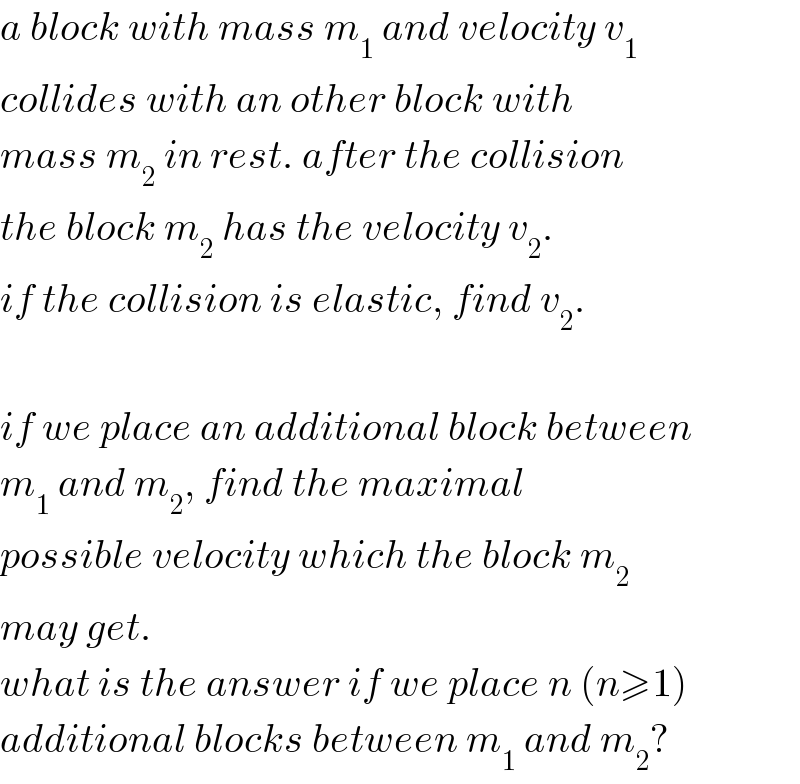Question Number 104987 by mr W last updated on 25/Jul/20

Commented by mr W last updated on 25/Jul/20

$${a}\:{block}\:{with}\:{mass}\:{m}_{\mathrm{1}} \:{and}\:{velocity}\:{v}_{\mathrm{1}} \\ $$$${collides}\:{with}\:{an}\:{other}\:{block}\:{with} \\ $$$${mass}\:{m}_{\mathrm{2}} \:{in}\:{rest}.\:{after}\:{the}\:{collision} \\ $$$${the}\:{block}\:{m}_{\mathrm{2}} \:{has}\:{the}\:{velocity}\:{v}_{\mathrm{2}} . \\ $$$${if}\:{the}\:{collision}\:{is}\:{elastic},\:{find}\:{v}_{\mathrm{2}} . \\ $$$$ \\ $$$${if}\:{we}\:{place}\:{an}\:{additional}\:{block}\:{between} \\ $$$${m}_{\mathrm{1}} \:{and}\:{m}_{\mathrm{2}} ,\:{find}\:{the}\:{maximal} \\ $$$${possible}\:{velocity}\:{which}\:{the}\:{block}\:{m}_{\mathrm{2}} \\ $$$${may}\:{get}. \\ $$$${what}\:{is}\:{the}\:{answer}\:{if}\:{we}\:{place}\:{n}\:\left({n}\geqslant\mathrm{1}\right) \\ $$$${additional}\:{blocks}\:{between}\:{m}_{\mathrm{1}} \:{and}\:{m}_{\mathrm{2}} ? \\ $$
Commented by ajfour last updated on 25/Jul/20

$${Great}\:{question}\:{Sir},\:{i}\:{can}\:{only}\:{hope} \\ $$$${to}\:{comprehend}\:{the}\:{solution}\:{when} \\ $$$${you}\:{shall}\:{post}\:{it},\:{tough}\:{one}\:{for}\:{me} \\ $$$${to}\:{even}\:{try}\:{and}\:{attempt}.. \\ $$
Answered by mr W last updated on 28/Jul/20

$${collision}\:{m}_{\mathrm{1}} \:{with}\:{m}_{\mathrm{2}} \:{directly}: \\ $$$${let}\:{u}_{\mathrm{1}} ={speed}\:{of}\:{m}_{\mathrm{1}} \:{after}\:{collision} \\ $$$${v}_{\mathrm{1}} ={v}_{\mathrm{2}} −{u}_{\mathrm{1}} \\ $$$${m}_{\mathrm{1}} {v}_{\mathrm{1}} ={m}_{\mathrm{1}} {u}_{\mathrm{1}} +{m}_{\mathrm{2}} {v}_{\mathrm{2}} \\ $$$${m}_{\mathrm{1}} {v}_{\mathrm{1}} ={m}_{\mathrm{1}} \left({v}_{\mathrm{2}} −{v}_{\mathrm{1}} \right)+{m}_{\mathrm{2}} {v}_{\mathrm{2}} \\ $$$$\mathrm{2}{v}_{\mathrm{1}} =\left(\mathrm{1}+\frac{{m}_{\mathrm{2}} }{{m}_{\mathrm{1}} }\right){v}_{\mathrm{2}} \\ $$$$\Rightarrow{v}_{\mathrm{2}} =\frac{\mathrm{2}{v}_{\mathrm{1}} }{\mathrm{1}+\frac{{m}_{\mathrm{2}} }{{m}_{\mathrm{1}} }} \\ $$$$ \\ $$$${with}\:{an}\:{additional}\:{block}\:{M}_{\mathrm{1}} : \\ $$$${V}_{\mathrm{1}} ={velocity}\:{of}\:{M}_{\mathrm{1}} \:{after}\:{collision} \\ $$$${V}_{\mathrm{1}} =\frac{\mathrm{2}{v}_{\mathrm{1}} }{\mathrm{1}+\frac{{M}_{\mathrm{1}} }{{m}_{\mathrm{1}} }} \\ $$$${v}_{\mathrm{2}} =\frac{\mathrm{2}{V}_{\mathrm{1}} }{\mathrm{1}+\frac{{m}_{\mathrm{2}} }{{M}_{\mathrm{1}} }}=\frac{\mathrm{2}^{\mathrm{2}} {v}_{\mathrm{1}} }{\left(\mathrm{1}+\frac{{M}_{\mathrm{1}} }{{m}_{\mathrm{1}} }\right)\left(\mathrm{1}+\frac{{m}_{\mathrm{2}} }{{M}_{\mathrm{1}} }\right)} \\ $$$$ \\ $$$${in}\:{general}\:{with}\:{n}\:{additional}\:{blocks}: \\ $$$${M}_{\mathrm{1}} ,{M}_{\mathrm{2}} ,…,{M}_{{n}} \\ $$$${v}_{\mathrm{2}} =\frac{\mathrm{2}^{{n}+\mathrm{1}} {v}_{\mathrm{1}} }{\left(\mathrm{1}+\frac{{M}_{\mathrm{1}} }{{m}_{\mathrm{1}} }\right)\left(\mathrm{1}+\frac{{M}_{\mathrm{2}} }{{M}_{\mathrm{1}} }\right)\left(\mathrm{1}+\frac{{M}_{\mathrm{3}} }{{M}_{\mathrm{2}} }\right)…\left(\mathrm{1}+\frac{{m}_{\mathrm{2}} }{{M}_{{n}} }\right)} \\ $$$$ \\ $$$${v}_{\mathrm{2}} \:{is}\:{maximum},\:{if} \\ $$$$\frac{{M}_{\mathrm{1}} }{{m}_{\mathrm{1}} }=\frac{{M}_{\mathrm{2}} }{{M}_{\mathrm{1}} }=\frac{{M}_{\mathrm{3}} }{{M}_{\mathrm{2}} }=…=\frac{{m}_{\mathrm{2}} }{{M}_{{n}} }={k} \\ $$$$\Rightarrow\frac{{m}_{\mathrm{2}} }{{m}_{\mathrm{1}} }={k}^{{n}+\mathrm{1}} \\ $$$$\Rightarrow{k}=\sqrt[{{n}+\mathrm{1}}]{\frac{{m}_{\mathrm{2}} }{{m}_{\mathrm{1}} }} \\ $$$$\Rightarrow{M}_{\mathrm{1}} ={km}_{\mathrm{1}} \\ $$$$\Rightarrow{M}_{\mathrm{2}} ={k}^{\mathrm{2}} {m}_{\mathrm{1}} \\ $$$$\Rightarrow{M}_{{n}} ={k}^{{n}} {m}_{\mathrm{1}} \\ $$$$\Rightarrow{v}_{\mathrm{2},\:{max}} =\frac{\mathrm{2}^{{n}+\mathrm{1}} {v}_{\mathrm{1}} }{\left(\mathrm{1}+{k}\right)^{{n}+\mathrm{1}} }=\left(\frac{\mathrm{2}}{\mathrm{1}+\sqrt[{{n}+\mathrm{1}}]{\frac{{m}_{\mathrm{2}} }{{m}_{\mathrm{1}} }}}\right)^{{n}+\mathrm{1}} {v}_{\mathrm{1}} \\ $$
